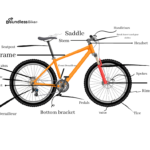As a cyclist, you know how important it is to have the right equipment for your ride. From choosing the perfect bike frame to selecting the best pedals, every component plays a vital role in your performance on the road. But have you ever stopped to think about handlebars?
These seemingly small components can make a big difference in your riding experience, and even professional cyclists take their handlebar choice seriously. In this blog post, we’ll dive to know what handlebars do the pros use and help you choose the best ones for your bike and riding style. Let’s get started!
What Handlebars Do The Pros Use?

Professional cyclists have specific preferences when it comes to handlebars. The type of handlebar they choose depends on their riding style, personal preference, and even the terrain they’ll be cycling on.
Some pros prefer traditional drop bars, which offer multiple hand positions for comfort during long rides. Others opt for the more aerodynamic option of aero bars or bullhorns for time-trial events. Mountain bikers often go with wider flat or riser bars that provide better control and stability on rough terrain.
One popular choice among professional road cyclists is the compact bar, also known as a shallow drop bar. This type of handlebar has less reach and drop than traditional bars but still offers multiple hand positions for comfort over long distances.
Ultimately, pro cyclists choose handlebars based on their individual needs and preferences. It’s important to explore different options before settling on one that works best for you and your riding style.
The Best Handlebars for Each Type of Bike
Choosing the right handlebars for your bike is crucial to achieve maximum comfort, control, and performance. Each type of bike requires a specific handlebar design that suits its intended use.
- For road bikes, drop bars are the most popular choice among professionals as they offer multiple hand positions for different riding conditions. Drop bars also provide excellent aerodynamics which is essential for high-speed cycling.
- Mountain bikers prefer flat or riser bars as they provide more stability and better leverage on technical terrain. Flat bars are perfect for cross country while riser bars offer more control in downhill rides.
- Hybrid bikes usually have either flat or upright handlebars depending on their intended use. Flat handles offer more speed while upright ones allow a more comfortable sitting position that’s suitable for commuting and leisurely rides.
- Touring bikes commonly use butterfly or trekking handlebars that provide plenty of hand positions suitable for long-distance cycling. These types of handles also make it easier to carry loads at the front end of the bike without compromising balance and stability.
Handlebars Used by Pros
Handlebars are an essential component of any bike, and the type of handlebar a cyclist chooses can have a significant impact on their riding comfort and performance. For pro cyclists, handlebars are even more critical as they strive for maximum efficiency in high-pressure races.
One popular choice among professional cyclists is the drop bar, which allows riders to change hand positions easily while maintaining good aerodynamics. This type of bar is commonly seen on road bikes and time trial bikes used in competitions like the Tour de France.
Another option for pro cyclists is the flat bar, typically found on mountain bikes. Flat bars offer greater control over technical terrain but may not be as comfortable for long rides due to limited hand positions.
There are also various types of specialty handlebars preferred by some pros such as bullhorns or aerobars which offer different benefits depending on rider preference and specific race requirements.
Professional cyclists choose their handlebars based on factors such as comfort level, riding style preferences, and competition requirements. Ultimately it’s about finding what works best for each individual rider so they can perform at their highest level possible.
How to Choose the Right Handlebars
Choosing the right handlebars for your bike can be a daunting task, but it’s crucial to find the perfect fit for your riding style and body measurements. There are several factors to consider when selecting handlebars, including shape, material, width, and rise.
Firstly, think about the type of riding you’ll be doing. If you’re into road biking or racing, drop bars might be a great option as they offer an aerodynamic position on the bike. For mountain biking or trail riding though, flat bars could provide more control and stability.
Next up is material- aluminum may be lightweight but carbon fiber offers more vibration-damping properties. Width is also important – wider bars increase leverage while narrower ones provide better aerodynamics in certain situations.
Consider rise- higher rises allow riders to sit more upright while lower ones prioritize speed over comfort. Take accurate measurements of your body before making any final decisions- too wide or narrow handlebars will affect comfort levels and potentially cause pain.
What are Handlebars?
Handlebars are a crucial part of any bicycle, providing the rider with steering control and stability. They come in different shapes and sizes to accommodate various riding styles and preferences.
At their core, handlebars are simply a bar that attaches to the stem of the bike’s frame. The most common type is the straight handlebar, which is typically found on mountain bikes and hybrids. These bars provide good leverage for steep climbs but can limit hand positions.
Drop handlebars are commonly seen on road bikes, offering multiple hand positions for long rides or races. They allow riders to get into an aerodynamic position while still maintaining control over their steering.
Other types of handlebars include bullhorns and butterfly bars, each designed for specific purposes such as commuting or touring. Choosing the right type of handlebar depends on your riding style and comfort level.
The Different Types of Handlebars
When it comes to handlebars, there are several types available on the market. Each type offers a different riding position and style that suits different preferences and needs.
The drop handlebars are commonly used by road cyclists for their aerodynamic design. They allow riders to have multiple hand positions which can be useful during long rides or races. The bullhorn handlebars resemble the horns of a bull with its flat top and forward extensions that offer riders an aggressive position while still being comfortable.
Flat bars are popular among mountain bikers because they provide excellent control and stability over rough terrain. Its straight design allows riders to sit in a more upright position, reducing strain on the back. On the other hand, riser bars have an upward curve towards the rider which gives them better leverage when steering through technical trails.
Cruiser bars offer a relaxed riding posture with wide grips making them ideal for leisurely rides or commuting around town. Its swept-back shape also provides more clearance when maneuvering tight spaces like traffic or crowds.
Conclusion
The type of handlebars you choose will depend on your personal preference and the type of riding you plan to do. The pros use a variety of handlebars depending on their specific needs. It’s important to consider factors such as comfort, control, and aerodynamics when choosing your handlebars.
If you are looking for a more aggressive riding position and better aerodynamics, drop bars may be the best option for you. If you are looking for a more upright riding position and greater stability, flat bars or riser bars may be a better choice.
Ultimately, it’s worth testing out different types of handlebars before making a final decision. Don’t be afraid to ask other riders what they prefer or consult with an expert at your local bike shop.
Remember that finding the right set of handlebars can make all the difference in terms of comfort and performance during long rides or races. So take some time to research and experiment with different options until you find what works best for you!
Also Read: How Wide Should Mountain Bike Handlebars Be? Quick Guide






